地下卅一年探秘亚洲第一长洞
——双河洞
周元杰 撰文
距今两亿两千万年前,云贵高原,只是远古海洋的一部分:千姿百态的海百合随着洋流摇摆,蜗贼、鹦鹉螺、三叶虫漫无目的地游弋,这些远古海洋生物一代接一代沉入海底,接着,是鱼龙、蛇颈龙……它们富含碳酸钙的骨骼在海床上不断堆积。
沧海桑田,平坦的海床抬升为嶙峋的高原。贵州娄山关寒武纪地层也被撕裂为“X”形的裂隙,随着水流的侵蚀,孕育出这个星球上独一无二的地下苍穹——绥阳双河洞穴系统。
最新数据显示:双河洞穴系统测量长度达 238.48公里,探明深度为594米,分为4层,有8条主洞道,200余条支洞,5条地下河;连接了双河水洞、响水洞、大风洞、山王洞、阴河洞、皮硝洞、龙潭子等52个洞口。
与拥有精美钟乳石的石灰岩洞穴不同,双河洞穴系统形成于白云岩及白云灰质岩岩层。支离破碎、宛如迷宫的洞道,从各个方向深入地壳,如皮肤之下的毛细血管,其存在远远超越了常人对洞穴的认知。
深渊访客
贵州省遵义市绥阳县温泉镇。
每年,这里都会迎来一群特殊的游客 :他们“旅行”的目的并非是为了享受空心面和地热温泉,而是要从这里前往这个星球上的未知地带之一 ——双河洞,人们将他们称作“洞穴候鸟”。
3月12日,“洞穴候鸟”们如约而至,“绥阳双河洞国家地质公园 2018年国际洞穴科考”拉开序幕。今年考察队来自中国、法国、加拿大和葡萄牙,他们中有地质学者、工程师、摄影师、自由职业者……这支阵容豪华的“国际探险队”的计划野心勃勃。
经过长达31年的系统科考,双河洞国家地质公园内的大型洞穴几乎被探险家们逐一连通,若要继续延伸洞穴的长度,就必须尝试找到新的通道。能符合条件的,要么是直通地下的竖井,要么是与世隔绝的天坑,要么是需要技术潜水才能穿越的深潭。不仅仅是人类,这里是所有地表生物的生命禁区。
神仙洞就是这样一个隐藏在密林中的通道,强劲而冰冷的洞穴气流冲出洞口,与洞外温暖的空气交汇形成白色的云雾,升腾缭绕,宛如仙境。

洞穴考察队员合影
3月20日上午11时许,测量小组一行五人到达海拔1217米的神仙洞洞口。小黑马(赵飞)、小葱(刘佳)以及来自法国、加拿大的三名探洞者一道,将深入神仙洞,尝试与双河洞主洞道连通。
“这是一个狭窄的地下裂缝,之后要进入一个垂直竖井。昨天,我们已经下降到约 200米的深度,后面还有竖井,今天携带了更多的绳索,希望够用。”作为先锋,小黑马胸前挂满了各式的技术装备。
相互检查好安全装备后,探洞队员依次进入神仙洞,他们所用的绳索是一条直径8.5毫米的尼龙绳,只比普通的铅笔粗一些,通过在合适的岩石上制作锚点,这条绳索将成为他们进出地下世界的“尼龙绳高速路”。
“越往下深入,岩壁越陡,但脚尖仍能触碰到岩石。横切过一片小小的岩架,就没有可踩的东西,四面都没有,自己悬在黑暗的半空。”小葱回忆。
下午 3点,5名队员全部到达地下 400多米的区域。这是一个从来没有人类涉足的空间,他们算得上是第一批点亮黑暗深渊的人类。除了岩石和水,这里似乎什么都没有。在地下河道中继续前进了约 1个半小时,河道消失了,河水汇聚成为一个水潭。
“需要通过洞穴潜水,才能知道水潭背后有什么,今天是不行了。”
返回地面的过程相当单调且漫长,一个绳段一次只能通过一人,洞穴深处阴暗寒冷,等待的队员裹在保温毯里,避免失温可能带来的危险。他们需要沿着绳子向上爬升相当于上海金融大厦的高度,晚上10时许,精疲力尽的队员们陆续返回地面。迎接他们的是洞口气流平静的呼吸声,还有夜空中闪烁的星光。
尽管没能潜到水潭背后,但他们依旧兴奋!他们知道,自己离目标又近了一步,那就是超越马来西亚清水洞成为亚洲长洞之冠!
地下马拉松
马来西亚沙捞越清水洞。
清水洞是赤道线附近最为壮观的洞穴系统之一。茂密的热带雨林之下,石灰岩山脉斜贯交错,洞中的水潭如空气般,近乎纯净见底。
2017年测量数据显示,清水洞测量长度达217公里,同年,双河洞的测量长度为 200公里。清水洞一直保持着领先优势,来自英国皇家科学院与马来西亚当地的的洞穴专家们做好了充分的准备,他们似乎已经习惯了双河洞探险家这种一年一度的穷追猛赶。
洞穴不同于山峰,探洞者不能像登山者那样,出发之前,就知道目标的海拔。哪怕是最有经验的探洞者,也无法判断黑暗中哪里才是尽头。如果没有现代洞穴学及洞穴测绘技术,洞穴或将永远游离于光怪的民间传说和迷信的烟雾中。如何才能准确描述庞大而繁复的洞穴呢?办法只有一个:一段段测量,一点点连通。
洞穴测绘有一套专门的标准:一个洞的长度,等于这个洞穴系统中所有主洞、支洞、竖井、地下河加起来的总长度。探洞者必须亲自进入洞道,记录洞穴中各点的坐标,并绘制出拥有完整数据的洞穴地图,最终确认洞穴的长度。
“1987年,贵州山地研究所对双河洞进行了首次测量,测量长度;17公里。”参与当年测量的李坡教授说,虽然在一百多年前,绥阳县温泉镇遍布的洞穴就已经被当地人熟知,不过第一次参加“体检”的双河洞,仅仅只是地下世界的一个“小不点”。
随着考察的深入,越来越多的外国大学及机构加入到对双河洞的探索 :日本秋田大学、东京都农业大学、早稻田大学、法国波尔多大学、法国洞穴联盟……
在中外探险家的通力合作下,双河洞就像一个青春期的少年,每年蹭蹭蹭地“长”长,2003年,双河洞系统的测量长度达到70.5公里,成为中国最长的洞穴。
2006年,双河洞测量长度再次被刷新,达到103.6公里,成为亚洲第二长洞,距离第一名——109公里的清水洞,仅差5.4公里,超越清水洞似乎指日可待。不过马来西亚同行一点儿没有停下来的意思。一年后,清水洞连通了新的支洞,达到150公里,继续领跑亚洲。
接下来的时日,清水洞与双河洞的探险家们似乎达成了某种默契,在地表深处的“马拉松”赛场上,他们竭尽全力,你追我赶,同时又相互交流彼此的发现,赞叹对方取得的成就,甚至帮助突破探洞中遇到的瓶颈。对于洞穴探险家来说,输赢并不重要。
“到达之前最远的测量点是一件非常艰辛的工作,很多时候,寻找一个测量点,就要在洞中走上 7、8个小时,之后开始测量,结束以后再花上同样的时间折返,每取得 100米的测量数据,都要花费巨大的心血。”贵州省洞穴协会秘书长钱治说,这个问题,同样困扰着马来西亚的同行。
双河洞地质公园一家客栈内,前方的探险小组会把将最新的测量数据在这里汇总。钱治介绍:“从 2017年到现在,我们在双河洞新探测了37公里,有9个新的洞口与双河洞主洞道连接,其中双河北部的碓窝洞天坑,就增加了8公里多。此外,今年还在双河发现了该系统中最深的竖井,深达535米,其中一段绳距就有350米。”
3月24日,在绥阳双河洞国家地质公园召开的“2018年国际洞穴科考新闻发布会”上,洞穴探险家、法国洞穴联盟驻中国联络官让·波塔西(Jean Bottazzi)向世界宣布:“最新数据显示,绥阳双河洞探测长度为238.48公里,首次超越长达222公里的马来西亚清水洞,成为亚洲最长洞穴,排名世界第六位。”
参与过双河洞科考的探险者们都知道,这次得来不易的超越只是“暂时”的,洞穴绝不会轻易交出自己所有的秘密,这正是一直以来,探险者们为之探索的动力——她仍然保持着独有的美,就像诞生之初那样!

皮硝洞 Mirabilite Hole

何教洞 Hejiao Hole
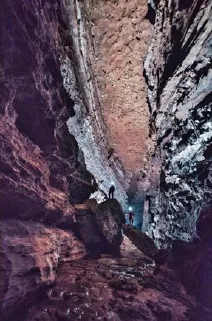
何教洞 Hejiao Hole

何教洞岔道 Hejiao Hole’s Turnoff
Thirty-one Years Underground Exploring the Longest Cave in Asia — Shuanghe Cave
Written by Zhou Yuanjie
220 million years ago, Yunnan-Guizhou Plateau was only part of ancient oceans: sea lilies swaying with the tides, nautiloids and trilobites casually cruising around. Generation after generation, these ancient sea lives sank to the seabed. Then came ichthyosaur and plesiosaurus…… Their bones, rich with calcium carbonate, piled up on the seafloor.
While time worked its magic, the flat seafloor rose up to become rugged plateau. The Cambrian stratum in Loushanguan, Guizhou, torn into an X-shaped crack, and eroded constantly by waters, gave birth to an underground kingdom that is unique to this planet - Shuanghe Cave Network in Suiyang County.
Latest data show that the measured length of Shuanghe Cave Network is as long as 238.48 kilometers, explored depth 594 meters, with 4 floors, housing 8 main cave tunnels, more than 200 branch tunnels, and 5 underground rivers;and it connects the entrances of 52 caves, including Shuangheshui Cave,Xiangshui Cave, Dafeng Cave, Shanwang Cave, Yinhe Cave, Pixiao Cave,and Longtanzi.
Unlike limestone caves with beautiful stalactites, Shuanghe Cave Network was formed from dolomite and dolomite limestone strata. Its fragmented,maze-like cave tunnels go deep into the earth crust from all directions, like blood capillaries under human’s skin. Its existence goes far beyond what we normally know about caves.
Visitors to the Underground Kingdom
Wenquan Town, Suiyang County, Zunyi City, Guizhou Province. Every year,a group of special visitors would come here. The goal of their trip is not to enjoy hollow noodles or geothermal hot spring. Instead, they come here to go to the last unknown area on Earth.
On 12th March, these “migrant birds to caves” arrived on time, kicking off the International Cave Expedition in Suiyang Shuanghe Cave National Geopark 2018. This year, expedition teams from China, France, Canada and Portugal recruited geologists, engineers, photographers, freelancers, etc. This high-level international expedition group came with an ambitious plan.
After 31 years of systematic and scientific expedition, explorers had connected almost all the major caves in Shuanghe Cave National Geopark, so they had to find new tunnels to further extend its length. The tunnels that can get the job done are either cenotes that go underground, or isolated sinkholes, or deep waters that can only be crossed through technical diving. They are forbidden areas not only to humans, but also to all aboveground lives.
Shenxian Cave, hidden in thick woods, is one of these tunnels. Strong and cold airflow rushes from inside to meet the warm outside air, forming lingering white fog, and creating a fairyland-like scenery.
At 11:00 am on 20th March, all five members of the measuring team arrived at the entrance of Shenxian Cave at an altitude of 1,217 meters. Black Horse(Zhao Fei) and Onion (Liu Jia), together with other three cave explorers from France and Canada, soon went into Shenxian Cave, trying to connect it with the main cave tunnels of the Network.
“It’s a narrow underground crack, and then we need to go into a vertical cenote. We went down as deep as around 200 meters yesterday, and there’s more cenotes. We brought more ropes today. Hopefully they’re enough.” As the vanguard of the team, Black Horse had various technical devices hanging in front of his chest.
After crosschecking all the safety equipment, the explorers entered Shenxian Cave one by one. The rope they used was a 8.5mm-thick nylon rope, only a bit thicker than a pencil. This rope would be their nylon expressway to get in and out of the underground kingdom through anchor points made on suitable rocks.
“The deeper we went, the steeper the rocks became. But our tiptoes could still touch the rocks along the tunnel. After a small piece of rock ledge, there was nothing for us to step on. Nothing at all. We just suspended in the dark midair.” Onion recalls.
At 3:00 pm, all five members arrived in the area more than 400 meters deep underground, which no human being had ever set foot on. They were the group of people who lightened up this dark deep space for the first time. Apart from rocks and water, there seemed to be nothing in it. After proceeding for around 1 hour and a half along the underground riverway, the river disappeared and the water gathered together to form a pool.
“We need cave diving to find out what’s on the other side of the pool. We won’t be able to do it today.”
It was a boring and long process to the ground. One piece of rope allowed only one person to get through. In the deep, dark and cold cave, the team members who were waiting for their turn wrapped a blanket around themselves to keep warm, protecting themselves from possible dangers caused by body temperature loss. They needed to climb along the rope up to the same height as Shanghai World Financial Center. Around 10:00 pm, all of the exhausted explorers finally made it to the ground. However, there was no grand ceremony to welcome their triumphant return, neither was there flashlights,flowers, or applause, not even a single person waiting for them, but only the quiet breaths of airflows at the cave entrance and the twinkling stars in the sky.Even though they didn’t get past the pool, they were still excited, because they knew that they were one step closer to their goal.
Underground Marathon
4000 kilometers away, Clearwater Cave, Sarawak, Malaysia. Clearwater Cave is one of the most splendid cave systems near the Equator. In the thick tropical rainforest, limestone mountains crisscross each other, and the pools in the caves are almost as limpid as air.
Measurements from 2017 show that the length of Clearwater Cave was 217 kilometers, and in the same year, that of Shuanghe Cave was 200 kilometers.Clearwater Cave had maintained its leading position, and the cave experts from the Royal Society of London and from Malaysia, who seemed to be used to the intense catching-up of the Shuanghe Cave explorers, were well prepared.
Caves are different from mountains. Cavers, unlike mountain climbers, don’t know the altitude of their target before setting off. Even the most experienced cave explorers can’t predict where the darkness ends. Without modern speleology and cave surveying and mapping technologies, caves would always exist in bizarre folk legends and superstition. How to accurately describe massive and complicated caves? There’s only one way to do it:measure and connect them section by section.
There’s a set of standards specific to cave surveying and mapping: the length of a cave system equals the total length of all its main caves, branch tunnels,cenotes, and underground rivers. The explorers must go into the cave tunnels,record the coordinates of the points, map out the cave system with complete data, and then, the length of the cave is finally determined.
“In 1987, the Institute of Mountain Resources from Guizhou Academy of Sciences did the measurement of Shuanghe Cave for the first time, and the length was 17 kilometers.” Recalls Professor Li Po, who engaged in the measurement. Although the caves spreading all over Wenquan Town were familiar to locals as early as more than one century ago, Shuanghe Cave could only be considered as “tiny” in the underground world when it was first examined back then.
As the exploration deepened, more and more foreign universities and organizations joined in the exploration of Shuanghe Cave: Akita University,Tokyo University of Agriculture, and Waseda University from Japan,University of Bordeaux, and French Cave Alliance...
Thanks to the united efforts of domestic and foreign explorers, Shuanghe Cave, like a teenage boy, grew longer and longer each year. In 2003,Shuanghe Cave Network was measured to be 70.5 kilometers, becoming the longest cave in China.
Shuanghe Cave broke its record again in 2006 in length, reaching 103.6 kilometers, ranking the second in Asia, only 5.4 kilometers shorter than the first—Clearwater Cave with the length of 109 meters. It seemed that it could be expected soon to surpass the Clearwater Cave, but the Malaysian counterparts showed no intention to stop and wait. One year later, new branch tunnels were connected in Clearwater Cave, making its length 150 kilometers,and thus securing its leading place in Asia.
After that, the explorers of Clearwater Cave and Shuanghe Cave seem to have reached a tacit understanding. They spare no efforts in this Marathon race deep underneath Earth’s surface. They try their best to outdo the other, while exchange their new findings, appreciate each other’s accomplishments, even help each other to break through the bottlenecks during exploration. Cave explorers don’t care much whether they win or lose.
“It’s an arduous job to get to the farthest measuring points. In most cases, to find a measuring point, we need to walk in the cave for 7 or 8 hours, and then start to measure. When the measurement finishes, it takes the same amount of time to return. It takes a lot of efforts to obtain the measurement data of every 100 meters.” Says Qian Zhi, secretary-general of Guizhou Cave Association.Their Malaysian counterparts are also troubled by this problem.
In an inn in Shuanghe Cave Geopark, all the exploration teams would pool together their latest measurement data. Qian Zhi says, “Since 2017 till now, we have explored another 37 kilometers of Shuanghe Cave, connected another 9 cave entrances to the main cave tunnels. Among them, Duiwo Cave Sinkhole in the north of Shuanghe Cave added more than 8 kilometers to its total length.More than that, we discovered the deepest cenote in the system this year, as deep as 535 meters. One single pitch is 350 meters.”
On 24th March, at the International Cave Expedition Press Conference hosted by Shuanghe Cave National Geopark, Jean Bottazzi, a caver, the liaison officer of French Cave Alliance in China, announced to the world: “Latest data show that the measured length of Suiyang Shuanghe Cave is 238.48 kilometers, for the first time, surpassing Clearwater Cave from Malaysia with a length of 222 kilometers, becoming the longest cave in Asia, and ranking the sixth in the world.”
The explorers who have participated in the exploration of Shuanghe Cave know that this surpassing didn’t come easily, and it’s just temporary. Caves do not reveal themselves easily, and this is exactly the reason driving explorers forward—she is just as unique and beautiful as when she was born!
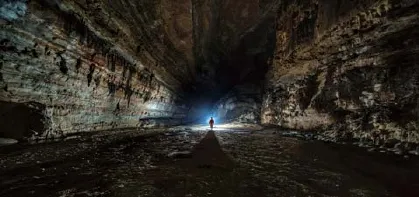
何教洞地下河水道 Underground Stream in Hejiao Hole

何教洞内生长中的钟乳石 Stalactites in Hejiao Hole

皮硝洞 Mirabilite Hole

铜鼓皮硝洞采硝遗迹 Saltpeter Mining Remains in Bronze-drum Mirabilite Hole

考察队员查看洞中硬石膏 Expeditioners Examining Anhydrite in the Hole
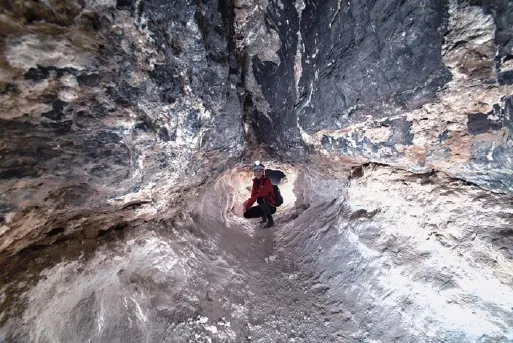
石膏洞 Gypsum Hole

山王洞(大厅) Mountain King Hole (Hall)
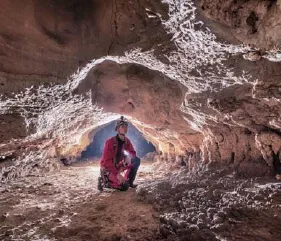
山王洞(支洞) Mountain King Hole (Side Hole)

考察队员在洞中匍匐前进 Expeditioners Crawling in the Hole
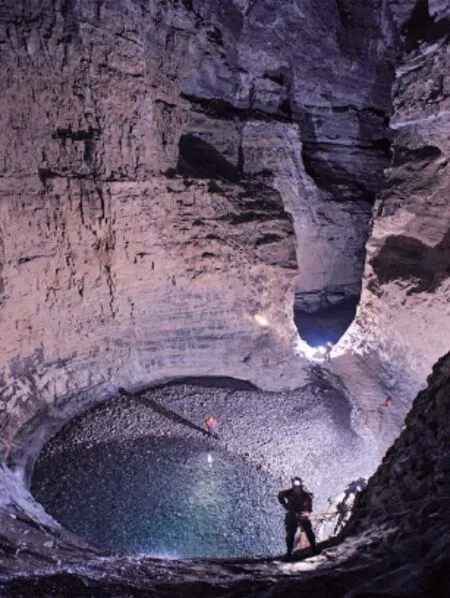
洞内地下瀑布会在雨季焕发生机 Underground Falls Come Alive in Rainy Season

在洞内发现的斑灶马 Tachycines Hoffmanni Found in the Hole
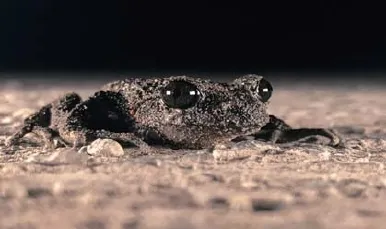
洞内发现的红点齿蟾 Oreolalax Rhodostigmatus Discovered in the Hole

石膏卷曲石 Ram's Horn Selenite

